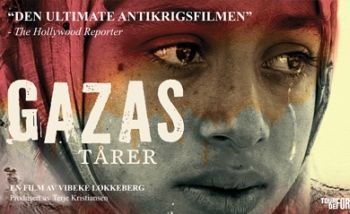
Publisher:
Bonnie King
CONTACT:
Newsroom@Salem-news.com
Advertising:
Adsales@Salem-news.com

~Truth~
~Justice~
~Peace~
TJP
Dec-13-2010 22:57


 TweetFollow @OregonNews
TweetFollow @OregonNews
New Film: Tears of Gaza
Steve Gravestock and Vibeke Løkkeberg Special to Salem-News.comCan war solve conflicts or create peace?
 Learn more, visit: nfi.no |
(TORONTO) - In a rough style, by way of unique footage, the brutal consequences of modern wars are exposed. The film also depicts the ability of women and children to handle their everyday life after a dramatic war experience. Many of them live in tents or in ruins without walls or roofs. They are all in need of money, food, water and electricity. Others have lost family members, or are left with seriously injured children. Can war solve conflicts or create peace? The film follows three children through the war and the period after the ceasefire.
Disturbing, powerful and emotionally devastating, Tears of Gaza is less a conventional documentary than a record – presented with minimal gloss – of the 2008 to 2009 bombing of Gaza by the Israeli military. Photographed by several Palestinian cameramen both during and after the offensive, this powerful film by director Vibeke Løkkeberg focuses on the impact of the attacks on the civilian population.
The film shuttles between the actual bombings and the aftermath on the streets and in the hospitals. The footage of the bombs landing is indelible and horrifying, but it is on par with much of the explicit imagery on hand. White phosphorous bombs rain over families and children, leaving bodies too charred to be identified. The footage here is extremely graphic and includes children’s bodies being pulled from ruins. Recounting the horrors she has witnessed, one young girl collapses and sinks out of the frame.
Years of economic embargo have left the area deprived of resources and have strained an already impoverished infrastructure. The wounded are carried to hospital for lack of ambulances, and an absence of fire trucks leaves home owners to put out fires on their own. What’s immediately apparent is that decades of military activity have made the population angry, nihilistic and vengeful. As one young boy says, “Even if they give us the world, we will not forget.” Løkkeberg contrasts these scenes with footage of bachelor parties, weddings and visits to the beach – social activities that epitomize daily life in Gaza during more peaceful times.
Tears of Gaza makes no overriding speeches or analyses. The situation leading up to the incursion is never mentioned. While this strategy may antagonize some, it’s a useful method for highlighting the effects of the violence on the civilian population. Similar events certainly occurred in Dresden, Tokyo, Baghdad and Sarajevo, but of course Gaza isn’t those places. Tears of Gaza demands that we examine the costs of war on a civilian populace. The result is horrifying, gut-wrenching and unforgettable.
The director, Vibeke Løkkeberg, about the film:
Witnessing the maiming and killing of children in a war, without being able to do anything about it, is a great challenge. The short glimpses of children’s faces displayed on my TV set, after they had lived through the war, was my motivation for making Tears of Gaza.
A protest against all wars grew inside me. Wars are senseless, destructive, unworthy of mankind. Wars are never a solution to bilateral problems in the long run.
In my films, I have always been concerned with the fate of the victims. In the Gaza-Israel conflict, there are presumably two victimized parties.
A responsibility which both the USA and Europe will have to shoulder. My hope is that this film will arouse the same feelings of protest among the audiences, and that it will bring inspiration to continue the seemingly endless struggle against poverty, suffering and war. In the film, I quote a father who sits with his phosphorous injured child: “What God do these people believe in, who can do this against children? And how can I gather the strength to forgive?”
This film has been a year in the making, and it’s a pleasure to let its world premiere take place in Toronto. I started my career as a documentary filmmaker. From the 1970’s on, I made feature films. In this film, I have chosen to make use of the implements of fiction, and the cinema theatre as venue. In contrast to TV, the cinema theatre provides the opportunity of absorption.
My hope is that this emotional approach will spur protest, and the desire to contribute to making a better world. There are major obstructions inherent in the presentation. The cinema theatres constitute a fantastic arena for communication which to a great extent has been taken over by the entertainment industry.
Special thanks to Gilad Atzmon
Articles for December 12, 2010 | Articles for December 13, 2010 | Articles for December 14, 2010

Quick Links
DINING
Willamette UniversityGoudy Commons Cafe
Dine on the Queen
Willamette Queen Sternwheeler
MUST SEE SALEM
Oregon Capitol ToursCapitol History Gateway
Willamette River Ride
Willamette Queen Sternwheeler
Historic Home Tours:
Deepwood Museum
The Bush House
Gaiety Hollow Garden
AUCTIONS - APPRAISALS
Auction Masters & AppraisalsCONSTRUCTION SERVICES
Roofing and ContractingSheridan, Ore.
ONLINE SHOPPING
Special Occasion DressesAdvertise with Salem-News
Contact:AdSales@Salem-News.com

Salem-News.com:
googlec507860f6901db00.html

Terms of Service | Privacy Policy
All comments and messages are approved by people and self promotional links or unacceptable comments are denied.
[Return to Top]
©2025 Salem-News.com. All opinions expressed in this article are those of the author and do not necessarily reflect those of Salem-News.com.